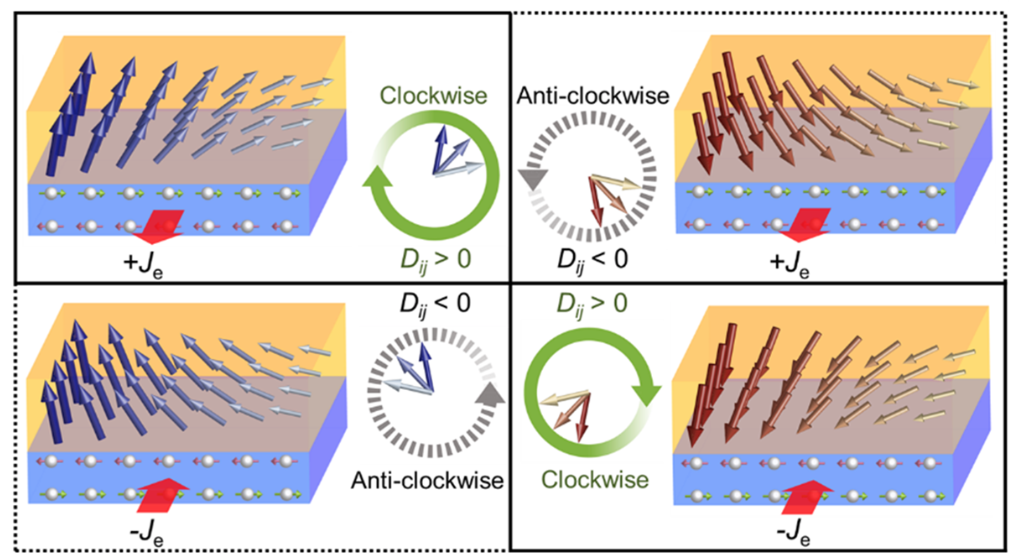Chiral Symmetry Breaking Enables Deterministic Switching in VCMA Devices
Outcome/Accomplishment
The National Science Foundation's (NSF) Engineering Research Center (ERC) for Translational Applications of Nanoscale Multiferroic Systems (TANMS) has demonstrated field-free deterministic spin-orbit torque (SOT) switching using the concept of chiral symmetry breaking. By using a gradient of magnetic properties, researchers introduced a non-collinear spin texture upon the application of SOT. The interplay between the chirality (or "handedness") of Dzyaloshinskii-Moriya interaction (DMI)—an antisymmetric exchange—and the induced non-collinear spin texture breaks the symmetry between up/down states and results in deterministic switching. The TANMS ERC is based at the University of California, Los Angeles (UCLA).
Impact/Benefits
Deterministic switching allows designers to engineer technologically useful nano-scale devices that feature low-energy-consumption and non-volatile magneto-electronics. The recent work at TANMS shows that deterministic switching can be realized by a slight modification of cobalt-iron-boron/magnesium oxide (CoFeB/MgO)-based heterostructures, without the requirement of additional layers. Furthermore, the concept can be applied to multilayers with uniform thicknesses, promising high potential for applications on wafer scales.
Chiral symmetry breaking is also compatible with voltage controlled magnetic anisotropy—known as the VCMA effect. The VCMA effect occurs when an electrode in a capacitor is made of a thin ferromagnetic metal and the magnetic properties of that ferromagnetic metal change as a result of the voltage being applied to the capacitor. Current VCMA devices allow for lower power and higher speed in data writing mechanisms. Likewise, technologies equipped with VCMA-MRAM (magnetic random access memory) outperform both spin transfer torque (STT)-MRAM and spin Hall effect (SHE)-MRAM devices in terms of both energy consumption and instruction-per-cycle (IPC). Because the chiral symmetry breaking advance at TANMS enables deterministic switching of VCMA devices, potential VCMA-SOT-MRAM technologies will leverage and stabilize all of these benefits while also gaining additional improvements in other areas such as latency.
Explanation/Background
TANMS researchers explored the use of a gradient of magnetic properties on a SOT application to create a non-collinear spin texture.Under current‐induced SOT, if there is a gradient of the total effective field, then a non‐collinear spin texture is formed resulting in a DMI energy in the system. Four possible states for different current and magnetization configurations were identified. Only two agree with the DMI sign of the system, leading to the deterministic switching (Figure 1). The researchers then found that the same concept can arise in samples with a perpendicular saturation magnetization (Ms) gradient. As a result, field‐free SOT switching in a Tantalum (Ta)/CoFeB/CoFe/MgO system (Figure 2) was demonstrated.
Location
Los Angeles, Californiawebsite
Start Year
Microelectronics and IT
Microelectronics, Sensing, and IT
Lead Institution
Core Partners
Fact Sheet
Outcome/Accomplishment
The National Science Foundation's (NSF) Engineering Research Center (ERC) for Translational Applications of Nanoscale Multiferroic Systems (TANMS) has demonstrated field-free deterministic spin-orbit torque (SOT) switching using the concept of chiral symmetry breaking. By using a gradient of magnetic properties, researchers introduced a non-collinear spin texture upon the application of SOT. The interplay between the chirality (or "handedness") of Dzyaloshinskii-Moriya interaction (DMI)—an antisymmetric exchange—and the induced non-collinear spin texture breaks the symmetry between up/down states and results in deterministic switching. The TANMS ERC is based at the University of California, Los Angeles (UCLA).
Location
Los Angeles, Californiawebsite
Start Year
Microelectronics and IT
Microelectronics, Sensing, and IT
Lead Institution
Core Partners
Fact Sheet
Impact/benefits
Deterministic switching allows designers to engineer technologically useful nano-scale devices that feature low-energy-consumption and non-volatile magneto-electronics. The recent work at TANMS shows that deterministic switching can be realized by a slight modification of cobalt-iron-boron/magnesium oxide (CoFeB/MgO)-based heterostructures, without the requirement of additional layers. Furthermore, the concept can be applied to multilayers with uniform thicknesses, promising high potential for applications on wafer scales.
Chiral symmetry breaking is also compatible with voltage controlled magnetic anisotropy—known as the VCMA effect. The VCMA effect occurs when an electrode in a capacitor is made of a thin ferromagnetic metal and the magnetic properties of that ferromagnetic metal change as a result of the voltage being applied to the capacitor. Current VCMA devices allow for lower power and higher speed in data writing mechanisms. Likewise, technologies equipped with VCMA-MRAM (magnetic random access memory) outperform both spin transfer torque (STT)-MRAM and spin Hall effect (SHE)-MRAM devices in terms of both energy consumption and instruction-per-cycle (IPC). Because the chiral symmetry breaking advance at TANMS enables deterministic switching of VCMA devices, potential VCMA-SOT-MRAM technologies will leverage and stabilize all of these benefits while also gaining additional improvements in other areas such as latency.
Explanation/Background
TANMS researchers explored the use of a gradient of magnetic properties on a SOT application to create a non-collinear spin texture.Under current‐induced SOT, if there is a gradient of the total effective field, then a non‐collinear spin texture is formed resulting in a DMI energy in the system. Four possible states for different current and magnetization configurations were identified. Only two agree with the DMI sign of the system, leading to the deterministic switching (Figure 1). The researchers then found that the same concept can arise in samples with a perpendicular saturation magnetization (Ms) gradient. As a result, field‐free SOT switching in a Tantalum (Ta)/CoFeB/CoFe/MgO system (Figure 2) was demonstrated.


